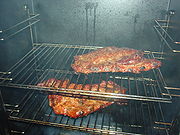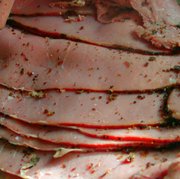Smoking (cooking)
Smoking is the process of flavoring, cooking, or preserving food by exposing it to the smoke from burning or smoldering plant materials, most often wood. Meats and fish are the most common smoked foods, though cheeses, vegetables, and ingredients used to make beverages such as whisky,[1] Rauchbier, and lapsang souchong tea are also smoked.

In Europe, alderwood is the traditional smoking wood, but oak is more often used now, and beech to a lesser extent. In North America, hickory, mesquite, oak, pecan, alder, maple, and fruit-tree woods such as apple, cherry and plum are commonly used for smoking. Other fuels besides wood can also be employed, sometimes with the addition of flavoring ingredients. Chinese tea-smoking uses a mixture of uncooked rice, sugar, and tea, heated at the base of a wok. Some North American ham and bacon makers smoke their products over burning corncobs. Peat is burned to dry and smoke the barley malt used to make whisky and some beers.
Historically, farms in the western world included a small building termed the smokehouse where meats could be smoked and stored. This was generally well-separated from other buildings both because of the fire danger and because of the smoke emanations.
Contents |
Types
- "Hot smoking" exposes the foods to smoke and heat in a controlled environment. Although foods that have been hot smoked are often reheated or cooked, they are typically safe to eat without further cooking. Hams and ham hocks are fully cooked once they are properly smoked. Hot smoking occurs within the range of 165°F/74°C to 185°F/85°C. Within this temperature range, foods are fully cooked, moist, and flavorful. If the smoker is allowed to get hotter than 185°F, the foods will shrink excessively, buckle, or even split. Smoking at high temperatures also reduces yield, as both moisture and fat are "cooked" away.
- "Smoke-roasting" refers to any process that has the attributes of both roasting and smoking. This smoking method is sometimes referred to as "barbecuing" or "pit-roasting". It may be done in a smoke-roaster, closed wood-fired oven or barbecue pit, any smoker that can reach above 250 °F (121 °C), or in a conventional oven by placing a pan filled with hardwood chips on the floor of the oven so the chips smolder and produce a smokebath. However, this should only be done in a well-ventilated area to prevent carbon monoxide poisoning.
- "Cold smoking" can be used as a flavor enhancer for items such as pork chops, beef steaks, chicken breasts, salmon and scallops. The item can be cold-smoked for a short period, just long enough to give a touch of flavor. Such foods are ready to be finished to order by such cooking methods as grilling, sauteing, baking, and roasting, or they may be hot smoked to the appropriate doneness for an even deeper smoked flavor. Smokehouse temperatures for cold smoking should be maintained below 100 °F (38 °C). In this temperature range, foods take on a rich, smokey flavor, develop a deep mahogany color, and tend to retain a relatively moist texture. They are not cooked as a result of the smoking process, however.
Wood smoke

Hardwoods are made up mostly of three materials: cellulose, hemicellulose, and lignin. Cellulose and hemicellulose are the basic structural material of the wood cells; lignin acts as a kind of cell-bonding glue. Some softwoods — especially pines and firs — hold significant quantities of resin, which produces a harsh-tasting soot when burned. Because of this, these woods are generally not used for smoking.
Cellulose and hemicellulose are aggregate sugar molecules; when burnt, they effectively caramelize, producing sweet, flowery, and fruity aromas. Lignin, a highly complex arrangement of interlocked phenolic molecules, also produces a number of distinctive aromatic elements when burnt, including smoky, spicy, and pungent compounds like guaiacol, phenol, and syringol, and sweeter scents like the vanilla-scented vanillin and clove-like isoeugenol. Guaiacol is the phenolic compound most responsible for the "smokey" taste, while syringol is the primary contributor to smokey aroma. (Hui 512) Wood also contains small quantities of proteins, which contribute roasted flavors. Many of the odor compounds in wood smoke, especially the phenolic compounds, are unstable, dissipating after a few weeks or months.
A number of wood smoke compounds act as preservatives. Phenol and other phenolic compounds in wood smoke are both antioxidants, which slow rancidification of animal fats, and antimicrobials, which slow bacterial growth. Other antimicrobials in wood smoke include formaldehyde, acetic acid, and other organic acids, which give wood smoke a low pH — about 2.5. Some of these compounds are toxic to people as well, and may have health effects in the quantities found in cooking applications. The compounds best demonstrated to have long-term health consequences are the polycyclic aromatic hydrocarbons, or PAHs, many of which are known or suspected carcinogens. Hotter wood fires make more PAHs; hot-burning mesquite produces twice as much as cooler-burning hickory.
Since different species of tree have different ratios of components, various types of wood do impart a different flavor to food. Another important factor is the temperature at which the wood burns. High-temperature fires see the flavor molecules broken down further into unpleasant or flavorless compounds. The optimal conditions for smoke flavor are low, smoldering temperatures between 570 and 750 °F (300–400 °C). This is the temperature of the burning wood itself, not of the smoking environment, which sees much lower temperatures. Woods that are high in lignin content tend to burn hot; to keep them smoldering requires restricted oxygen supplies or a high moisture content. When smoking using wood chips or chunks, the combustion temperature is often lowered by soaking the pieces in water before placing them on a fire.
Types of smokers
There are a few basic types of smoker designs, each with their own advantages and disadvanges.

Propane smoker
A propane smoker is a newer method that is designed to allow the smoking of meat in a somewhat more controlled environment. The primary differences are the source of heat and cause of the smoke. In a propane smoker, the heat is generated by lighting a gas burner. This lies directly under a steel or iron box that contains the wood or charcoal that is used to provide the smoke. The steel box has few vent holes which are on the top of the box only. By starving the heated wood of oxygen, it will smoke instead of burn. Any type of wood, charcoal or mix could be used. This method uses less wood and may be more convenient for some people.
Smoke box method
This is a more traditional method that uses a two box system: The fire box and the food box. The fire box is typically adjacent or under the cooking box, and can be controlled to a finer degree. The heat and smoke from the fire box exhausts into the food box, where it is used to cook and cure the meat.
Preservation
Smoke is a decent antimicrobial and antioxidant, but smoke alone is insufficient for preserving food in practice. The main problem is that the smoke compounds adhere only to the outer surfaces of the food; smoke doesn't actually penetrate far into meat or fish. In modern times, almost all smoking is carried out for its flavor. This flavoring can be purchased as a liquid in most supermarkets to mimic the flavor of smoking—not its preservative qualities—without the actual cooking process (see also liquid smoke).
In the past, smoking was a useful preservation tool, in combination with other techniques, most commonly salt-curing or drying. For some long-smoked foods, the smoking time also served to dry the food. Drying, curing, or other techniques can render the interior of foods inhospitable to bacterial life, while the smoking gives the vulnerable exterior surfaces an extra layer of protection. For oily fish, smoking is especially useful, as its antioxidant properties delay surface fat rancidification. (Interior fat isn't as exposed to oxygen, which is what causes rancidity.) Some heavily salted, long-smoked fish can keep without refrigeration for weeks or months. Such heavily-preserved foods usually required a treatment such as boiling in fresh water to make them palatable before eating.
Some smoked foods and drinks

- Fish
- Lox
- Smoked salmon
- Kippers
- Arbroath Smokies (haddock)
- Many pork products are cured and smoked
- Pastrami, pickled, spiced and smoked beef brisket
- Various sausages
- Traditionally-prepared jerky
- The malt used to make whisky
- Rauchbier
- Lapsang souchong tea leaves are smoked and dried over pine or cedar fires
- Prunes, which are dried plums, can be obtained through smoking
- Wumei are smoked ume fruit
- Chipotles are smoked jalapeño peppers
- Smoked Cheeses, such as smoked gouda
- Smoked salt
- Smoked paprika
Other home food preservation methods
|
|||||||||||||||||
References
- McGee, Harold (2004). On Food and Cooking (Revised Edition). Scribner. ISBN 0-684-80001-2. pp. 448–450, "Wood Smoke and Charred Wood"
- Hui, Y.H. (2001). Meat Science and Applications. Marcel Dekker. ISBN.
Notes
- ↑ McGee p. 767: "Malt whiskies from Scotland's west coast have a unique, smoky flavor that comes from the use of peat fire for drying the malt."